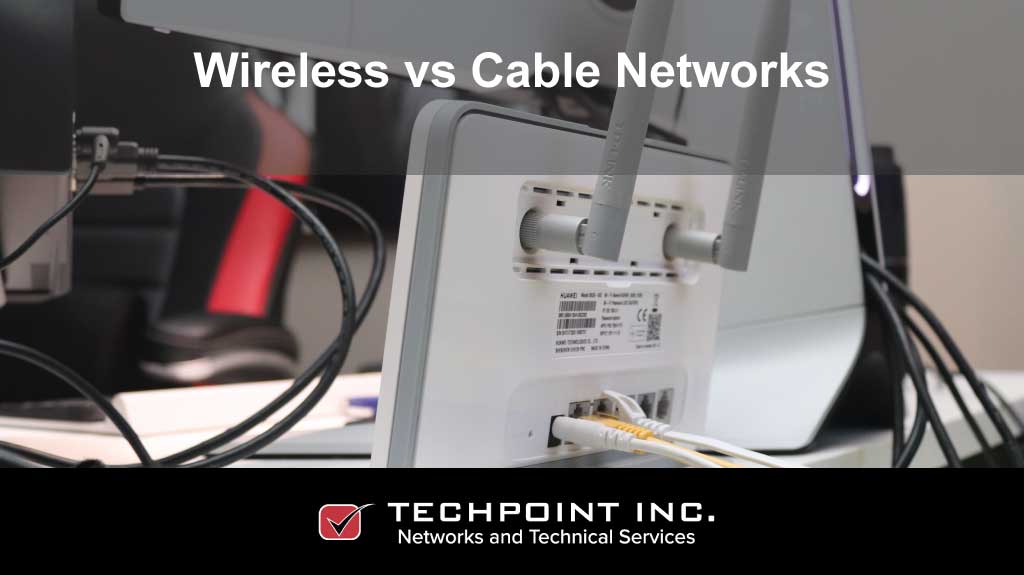Deciding between a wired or wireless network can be a challenging for businesses today. With advantages and disadvantages to both, knowing the differences can be a deciding factor when choosing which is best. Both networks need a structured cabling backbone, so the main difference is where the cables lie and how your networked devices are connected.
Here’s an overview of the main points to help you decide.
Wired Network
A wired network is where computers and other network devices are physically plugged into an Ethernet cable or wall jack.
Advantages
- Reliability and Stability: Wired networks tend to be more stable and reliable. When physically connected to the network, the chance of losing a connection is much lower.
- Visibility: A wired network is invisible to other wired networks. This means there’s no interference, and data transfer across the network is rarely compromised.
- Speed: Wired networks are much faster than wireless networks. Concrete walls and other items can be obstructions to wireless signals, and physical connections are always faster and more reliable.
- Security: Wired networks are broadly protected by routers and firewalls, and wired signals are protected by robust security technologies.
- Cost: Wired network hardware has a longer lifecycle than wireless.
Disadvantages
- Lack of mobility: A wired network is fairly restrictive in nature; you cannot pick up your laptop and move to a different location.
- Installation: Network installation can be a large project, ideally installed at the beginning of the construction of an office. The end user side of routers, switches, and hubs can require security and firewall configuration, which can be complex.
- Maintenance: Network servers require consistent administration to maintain connectivity, capacity, storage, and workload, which of course means an IT team member is required.
- Wires: Unless installed professionally, the workplace can become a mess of cables and components, which can be a hazard or inconvenience in the workplace.
There is a good balance of pros and cons to a wired network. Now let take a look at wireless networks.
Wireless Networks
Advantages
- Cost: The overall cost of wireless networks is largely based on where connectivity is required. Structured cabling is still required, but less connection hardware is necessary. The actual cost of wireless depends on your unique business model, the amount of wireless access points (WAPs) you need, and on any routers and other hardware you have.
- Installation: Installing, adding or upgrading wireless systems is much easier than cable; you do not need as much disruptive physical work, and it can be as simple as running a single cable to add a WAP to a new location.
- Mobility: Wireless connections allow workers the flexibility to accesses the network from any location on any device. Guests can easily join a public wi-fi connection and collaboration can be done anywhere.
Disadvantages
- Visibility: WiFi networks are visible to others, which can affect network performance, as well as security.
- Security: Wireless networks are less secure than wired. Signals transmitted through the air are far more likely to be intercepted if strong security technologies are not in place.
- Speed: While wireless internet keeps getting faster and faster, a hardwired connection will always be the fastest option. Hybrid configuration is always an option for internet connectivity, meaning you can have wireless internet along with some areas where you can hardwire in.
- Reliability: Stability of wireless networks can be prone to interference from other wifi networks or devices. Even walls can obstruct the connection, so the design of your network can make a big difference; ensure you have a professional install your network to ensure your space has even and reliable connectivity.
So which do you choose?
Every business is unique, so there’s no right or wrong answer here. Take into account all factors, such as security, stable connectivity, cost, and speed. Some businesses need 100% availability and fast speeds, while others need the flexibility that wireless provides. The most common solution is to have a main cable network with Wi-Fi access points, but ultimately, the choice rests with your own business requirements.
For additional help with your wireless or wired network, call TechPoint now!
